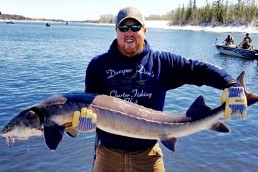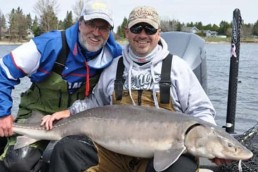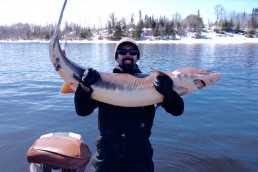Sturgeon: River Monsters of the North
SHARE THIS POST
Monster. Merriam Webster describes it as an animal of abnormal form or structure. Oxford dictionaries describes it as a large, ugly and frightening imaginary creature, a thing of extraordinary or daunting size. I am not really sure if they were thinking about lake sturgeon living in the Rainy River when they came up with these definitions, but in many ways, they certainly do fit.
One of the largest populations of lake sturgeon in the U.S. lives in the Rainy River. This scenic and winding waterway marks our international border with Canada in these parts and feeds the lake best known for walleyes, Lake of the Woods. This stretch of water is home to a strong and growing population of sturgeon. Both the number and average size of these prehistoric fish are on the rise and anglers are taking notice.
The sturgeon population has been getting healthier since the mid 1960s. Commercial netting was halted in the early 1930s. However, it wasn’t until legislation was passed with some teeth for the Clean Water Act in the mid-1960s that we started to see significant improvement.
A fish you’ll need a truck to haul out
In recent years, sturgeon fishing has started to gain popularity. The allure of catching a fish that currently can reach up to 120 pounds from the Rainy River is attractive to anglers. Typically, to catch a fish over 100 pounds, one would have to fish the ocean. Not anymore.
Lake sturgeon are the largest fish and the only sturgeon found amongst the Great Lakes basin. They are considered a near-shore, warm-water species preferring water temps of the low 50s to mid 60s and depths 15 to 30 feet. Their diet consists of small invertebrates such as insect larvae, crayfish, snails, clams, leeches and about any other small living creature that inhabits the river bottom.
Armored for life
Lake sturgeon have no scales, but have five rows of bone-like plates along its back and stomach called scutes. These scutes can be sharp when sturgeon are young and become dull as the fish gains age and size. These fish are tough. When you hold one, you quickly get a feel for the durability of the sturgeon’s outer armor.
Sturgeon can live to 100 years old and mature very slowly. It takes a female sturgeon on average 25 years and a male about 15 years before they can successfully reproduce. A female sturgeon reproduces every 4 years whereas a male spawns every other year. These characteristics of sturgeon, from a pure numbers perspective, make them slow to reproduce and they do not do so in big numbers. Consequently, it is important to take good care of these fish.
Taking the proper steps will help to ensure healthy populations down the road. After all, it is very possible the sturgeon you are handling is older than you are. Let’s remember to respect our elders!
Gearing up right
The first time you pitch your no-roll sinker and sturgeon rig loaded with crawlers and/or frozen shiners into the dark waters of the Rainy River could be the time you hook into a sturgeon 100-plus pounds. Be ready. Ethically, targeting monster fish with typical walleye-fishing gear probably isn’t a good idea. With light equipment, you are in for a fight over an hour long and the fish will be extremely exhausted once to the boat, lessening its chance for survival once released. Most sturgeon anglers come equipped with heavier rods, reels and line for the battle. Some use their muskie equipment, however, sturgeon bite light—almost a tap, tap, tap like a sunfish or a perch. Thus, having a rod with a flexible tip is helpful and will catch you more fish. Most muskie rods are very stiff.
In a nutshell, a hefty reel teamed with 60- to 100-pound-test line and an 8-foot rod is a good start. The heavier equipment will allow for a shorter fight, lessening the stress upon one of these prized dinosaurs.
Seriously tough tackle
On the tackle end of the setup, most use a flat “no-roll” sinker, typically about 3 to 4 ounces depending upon the current teamed up with a sturgeon rig, which is an 18-inch leader of 60-pound-test leader or heavy line with a 5/0 circle hook. The flat, “no-roll” sinker stays put on the bottom of the river and the circle hook allows for the sturgeon to get hooked in the mouth and not swallow the hook, avoiding mortality. Most anglers load the circle hook with a few nightcrawlers, some frozen shiners or both. The “no-roll sinkers” and sturgeon rigs are produced by a local company, Tom’s Tackle, and are available at local bait shops.
Do you have what you need?
Is your current net large enough for a 100-pound fish? Most anglers would answer no. A good, strong net is a good investment and works out well both for successfully landing a big fish and properly managing it once caught.
Are you enjoying this post?
You can be among the first to get the latest info on where to go, what to use and how to use it!
Taking a lesson from muskie anglers who also target big fish and have great respect for the fish, make sure everything is ready to roll and you have a plan when you do hook a big one. When you net the fish, leave the fish in the water as long as possible. If possible, remove the hook while in the water and in the net. Have your camera ready before bringing the fish aboard. Make sure to have tackle, rods and reels, etc out of the way. Have a clean area to maneuver.
A needle-nosed pliers is effective for removing hooks, a measuring tape (to measure length and girth), pencil or pen to record measurements and to record numbers if sturgeon is tagged (thousands have been by the Minnesota DNR), gloves (especially to handle the smaller sturgeon that have the sharp scutes), and a camera are all necessary equipment to have ready to roll.
Records from the Rainy River
The state of Minnesota now has a catch-and-release record for lake sturgeon, northern pike, muskies and flathead catfish. The last two state-record sturgeon, including the current state record, came from the Rainy River. Maybe you are next. The current state record measurements are 73 inches long with a girth of 30 inches. According to the Minnesota DNR length, girth, weight relationship chart, this fish is over 50 years old and weighs about 107 pounds.
Know how to hold ‘em
Know how to handle big fish before you hit the water for these river monsters. Fish are meant to swim horizontally in the water, not held vertically out of the water. The chance of injuring a fish from simply holding it vertically increases with larger fish as the sheer weight of the organs inside the body cavity can tear away membrane internally, causing death at a later time after the fish appears to swim away healthy.
If the sturgeon is too big, consider not bringing on board. If it is a fish you can handle, use two people. One person can grab the fish behind the pectoral fins, the other the tail. Support the weight of the fish under its belly, ultimately holding it horizontally. Do not drop the fish. Take care in not touching the eyes, gills or gill plates. The gill plates look tough, but they will tear, causing eventual death.
Know how to show ‘em
Don’t be shy; cradle the fish with both arms for the picture. Take pictures quickly and get the fish back into the water. Support the fish in the water until the fish shows signs of swimming away. It is not a good idea to go forward and back with a fish in the water. Rather, a gentle side to side motion is better for revival. A fish can actually drown by pulling it backwards too much in the water.
Know when to let ‘em go
Most sturgeon anglers practice catch and release. There is a “keep” season in which anglers are allowed during designated dates to keep one fish per calendar year 45 to 50 inches or over 75 inches. Anglers desiring to harvest a sturgeon must first purchase a sturgeon tag and mail-in registration card. Anglers tag and register their sturgeon, much like a deer.
There are “catch and release” seasons in which anglers can lawfully fish for sturgeon with a valid Minnesota fishing license during the open season. No tag is needed to catch and release. Anglers looking to catch and release sturgeon can also fish during the “keep” season.
Finally, there is a stretch from mid May through June in which the sturgeon season is closed to any sturgeon fishing. Check the Minnesota DNR fishing regulations for details.
Get someone with know-how
If you have the desire to catch a river monster, but don’t have a boat or the equipment, there is a great option. Most resorts in the area are set up for sturgeon fishing or have guides who take you out. They provide everything you need for an enjoyable and usually successful day on the water. This typically includes the guide, boat, rods, reels, tackle, bait and a good idea of some of the best sturgeon holes in the river.
Catching a big lake sturgeon is an experience of a lifetime. The excitement of hooking fish with prehistoric roots on the Rainy River is unforgettable. The raw power of a huge fish doubling your rod and ripping line off of your reel with ease gets noticed. Imagine feeling your arms burn trying to persuade this fish off of the bottom and, in a flash, this prehistoric looking fish is flying out of the stained water and then running under the boat. Not your typical day fishing and certainly, not your typical fish. Don’t be afraid of monsters.
MWO
SHARE THIS POST
Did you enjoy this post?
You can be among the first to get the latest info on where to go, what to use and how to use it!
Joe Henry
Tournament angler and licensed charter captain Joe Henry fishes and hunts the Midwest. Henry is a media member of AGLOW and writes for numerous publications, creates videos, appears on a variety of outdoor TV and radio shows and is a frequent seminar speaker. Henry is the Executive Director of Lake of the Woods Tourism.



